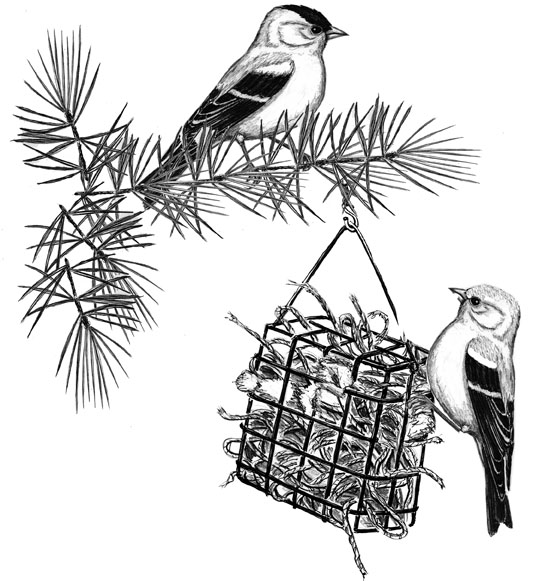
Dear Bird Folks,
It’s mid-August and the goldfinches are still collecting dog hair and cotton fibers from the fluff dispenser in my yard. I enjoy watching them, but why are they coming so late in the season? Does this mean they are working on a new brood? My chickadees, titmice and flickers have fledged long ago.
– Fran, Dennis, MA
Very interesting, Fran,
It’s great that you are seeing goldfinches gathering nesting material, especially this time of year. But what I find interesting is that you have a “fluff dispenser” in your yard. Our fluff dispenser is in the kitchen, where we use it to dispense another kind of fluff…Marshmallow Fluff. Sometimes there are a few dog hairs and cotton fibers in our Fluff, too, but usually it’s just my spoon.
In life, we occasionally finish first and other times we end up last. That’s just the way it goes. Sometimes we pick the fast-moving line at Stop & Shop, while other times we get stuck behind the person who insists on using a coupon that expired in 1998. But when it comes to nesting birds, the order is far less random. Here in New England, the first birds to lay their eggs each year are the Great Horned Owls. Owl couples can be seen breeding as early as mid-February. (Apparently, Valentine’s Day really puts them in the mood.) Over the next five months, a steady stream of hawks, ducks, sandpipers and songbirds will couple-up, mate and raise a family, or two. As June turns into July, all the birds I have just mentioned will wind down their breeding chores for the year, but not the goldfinches. Summertime is when they can be seen searching for a mate, building a nest and making regular visits to the nearest fluff dispenser.
Bird breeding cycles are typically based on food availability. Owls get started early, before spring foliage has a chance to hide their prey (squirrels, rabbits, etc.). Songbirds wait a bit longer. They time their nesting season around the hatching of insects, which provide needed food for their growing nestlings. Goldfinches, on the other hand, have no use for insects, or squirrels or rabbits. They are strict vegetarians (and proud of it). Instead, they time their nesting season around flowers, but not blooming flowers as the hummingbirds do. Goldfinches seek flowers that are at the end of their blooming cycle and are starting to dry up, looking like the flowers I regrettably bought for my wife one time. (That’s what I get for using a coupon that expired in 1998.)
When it comes to nest building, it is the female finch (as usual) that does all the work. She looks for a forked branch on a small tree or shrub, but not just any old fork. She’s fussy and routinely tests several locations before choosing the perfect one. Like selecting an easy chair in a furniture store, the female will settle onto each fork, wiggle her body around, change positions a few times, trying to get comfortable, before checking out the next fork. But unlike a furniture store, she won’t be pressured into purchasing a bogus warranty or some sketchy stain guard.
If I was a baby bird, I think I’d like to be born in a goldfinch nest. They are durable, soft and really cozy. The shell consists of stems, grasses and rootlets, which are all held together with spider silk. Once the shell is finished, the female lines the cup with a cushy layer of cattail fuzz, thistledown and in one particular nest in the town of Dennis, cotton fiber and dog fur. The male doesn’t help with the building process, but he’s right by the female’s side the entire time. Some people may interpret this closeness as “love,” while chauvinists might claim that he is trying to make sure she’s “doing it right.” Actually, it’s neither of those things. He’s “mate guarding.” That’s right; he’s just keeping the other males away. Sorry, romantic types. When it comes to breeding, birds are all business.
After the eggs hatch, dad swings into high gear. His job is to provide food for the entire family, including the female. While she keeps the chicks warm and safe, he visits flower after flower, gathering seeds. At first, he only gives the food to the female and she distributes it to the babies. (I guess she doesn’t trust him to do it right.) But after a few days, he begins to help her feed the nestlings, and eventually, he does all of the feeding by himself. What a guy!
We have established that finches are the last birds to nest each season, but building a nest in mid-August is indeed late, even by finch standards. Why so late this year? There are two possibilities: First, not all initial nesting attempts are successful. Sometimes entire broods are lost to storms or predators. If that is the case, the birds may attempt to re-nest. Or, some older females, with years of experience, might begin the nesting process earlier in the season. Then, while her mate is taking care of her first brood, she’ll hook up with another partner and start a second family. I know doing that sounds kind of improper, but remember, in the bird world, it’s all about business…even if it’s “funny business.”
I’m glad you left your fluff dispenser up for so long, Fran. I’m sure the goldfinches appreciate it. You are more considerate than I am. I took mine down weeks ago. Well, I took the outside fluff dispenser down. The inside Fluff dispenser is still up and running. That one never comes down.